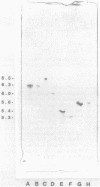Abstract
Five plasmid-mediated beta-lactamases conferring high-level resistance to ceftazidime were isolated from Klebsiella pneumoniae strains in the same hospital. These enzymes had isoelectric points ranging from 5.3 to 6.5 (CAZ-1, 5.55; CAZ-2, 6.0; CAZ-3, 5.3; CAZ-6, 6.5; and CAZ-7, 6.3). All isolates and their Escherichia coli transconjugants were highly resistant to amoxicillin (MICs, greater than 4,096 micrograms/ml), piperacillin (64 to 256 micrograms/ml), cephalothin (32 to 256 micrograms/ml), and ceftazidime (32 to 512 micrograms/ml) but remained moderately susceptible to cefotaxime (0.5 to 8 micrograms/ml). Only CAZ-6- and CAZ-7-producing strains were highly resistant to aztreonam (64 to 128 micrograms/ml). All the isolates remained susceptible to moxalactam and imipenem. The reduced activity of piperacillin, cefotaxime, ceftazidime, or aztreonam was restored by 2 micrograms of clavulanate, sulbactam, tazobactam, or brobactam per ml for E. coli producing CAZ-2, CAZ-3, and CAZ-7. Sulbactam had a lower protective effect than other inhibitors for E. coli harboring CAZ-1 and especially CAZ-6. Except for CAZ-1, which was mediated by a 150-kilobase (kb) plasmid (pCFF14), the other ceftazidimases were mediated by plasmids of 85 kb with EcoRI digestion patterns similar to that of pCFF04 encoding CTX-1 beta-lactamase. A TEM probe hybridized with a 19-kb EcoRI fragment of all these closely related plasmids.
Full text
PDF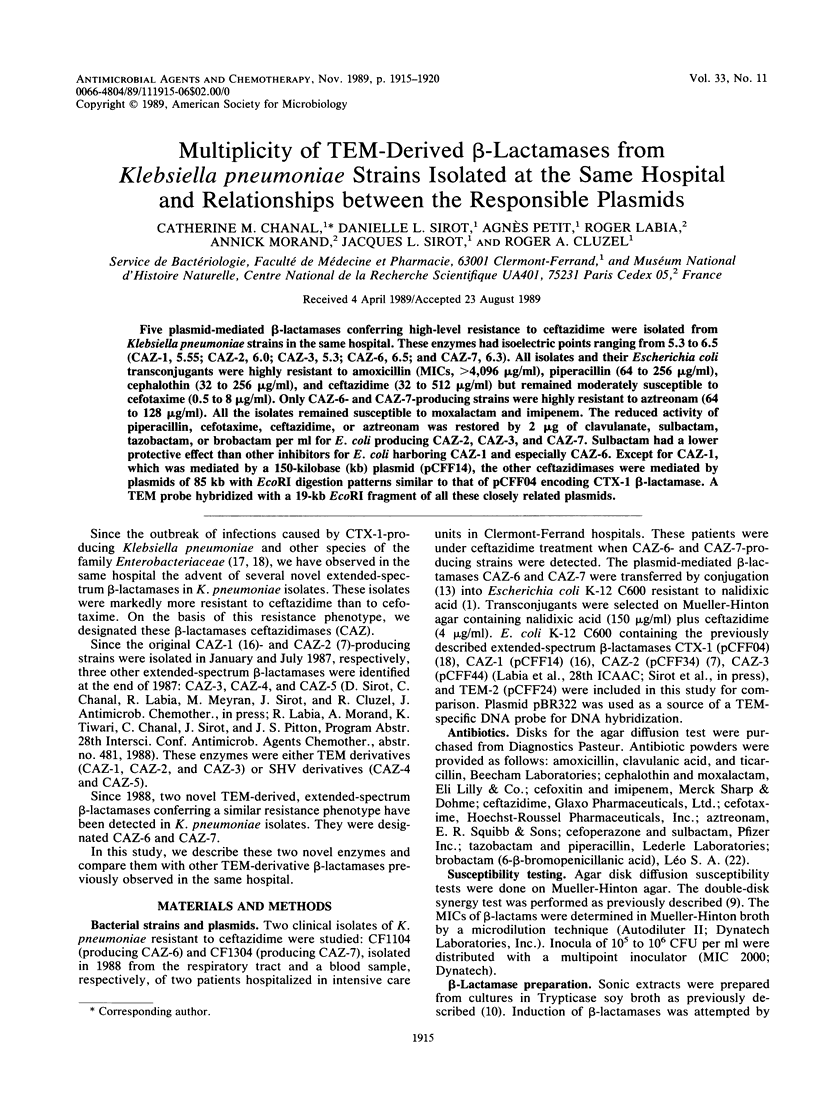
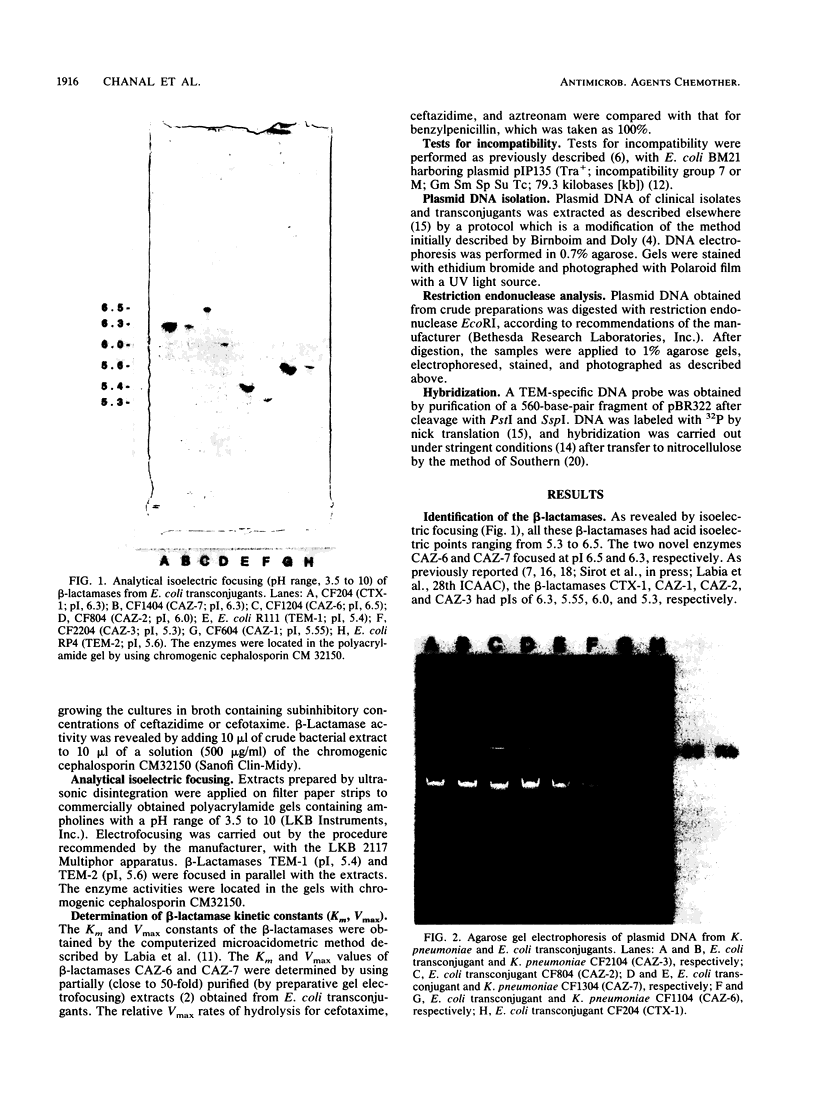
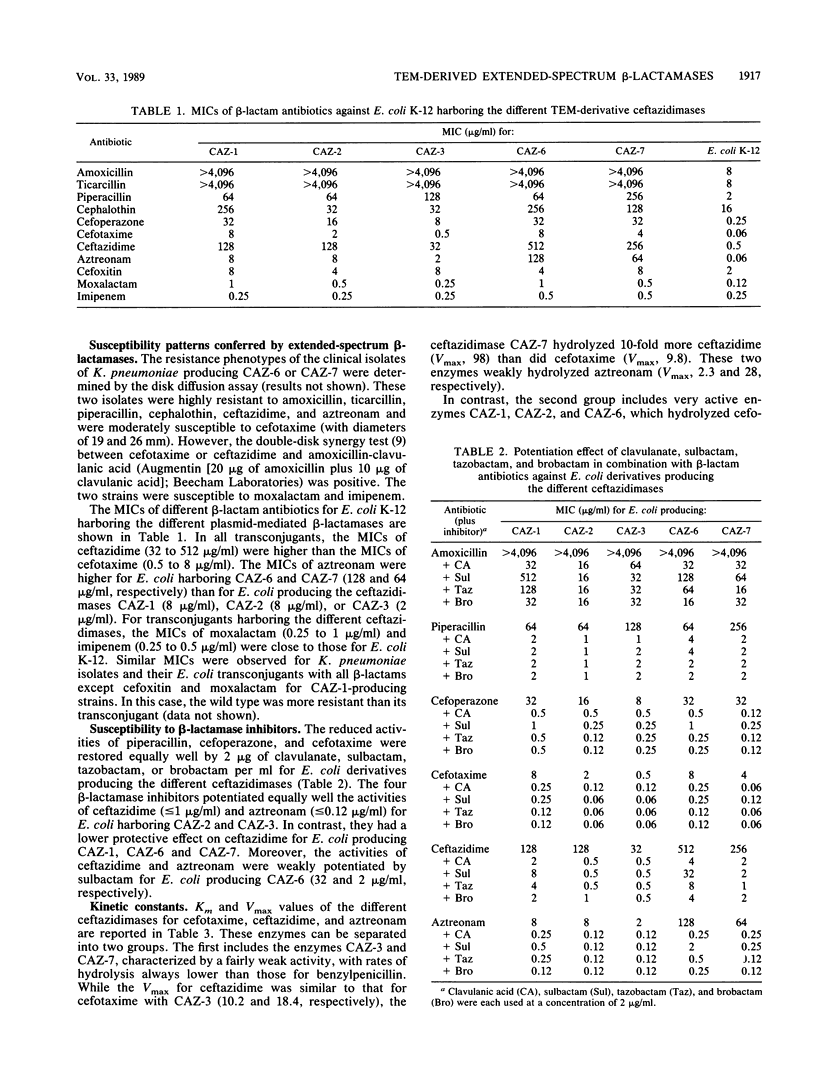
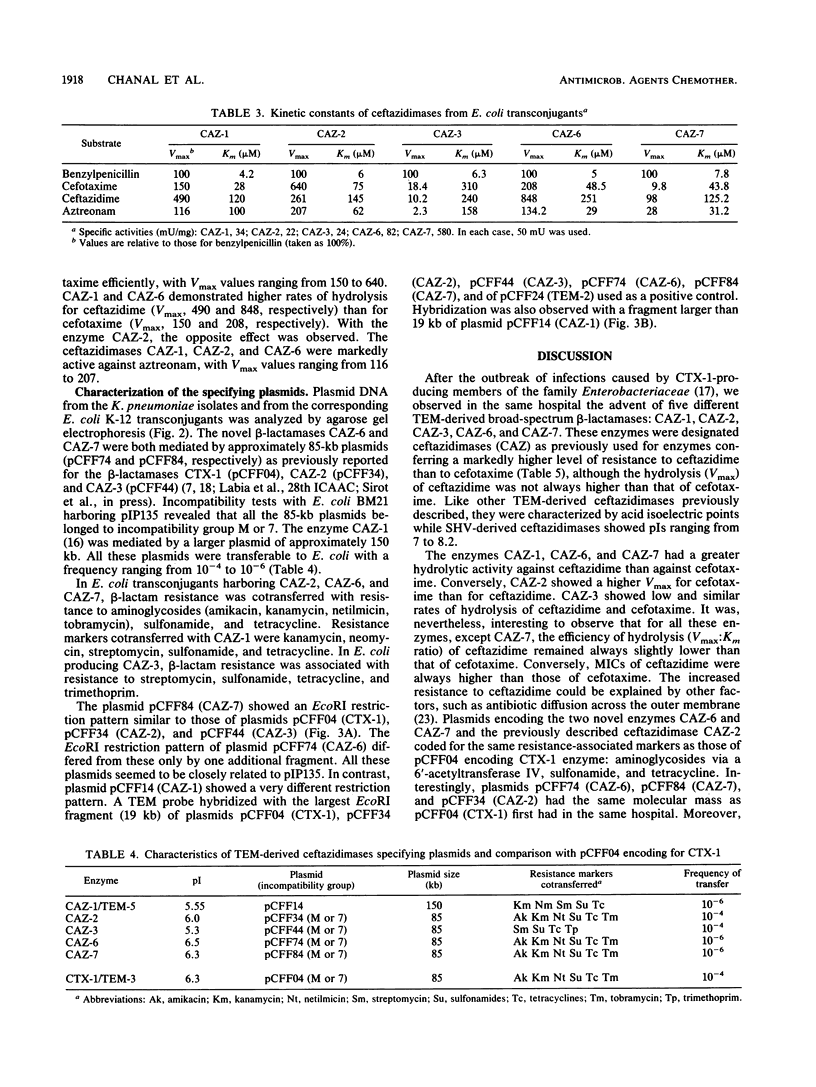
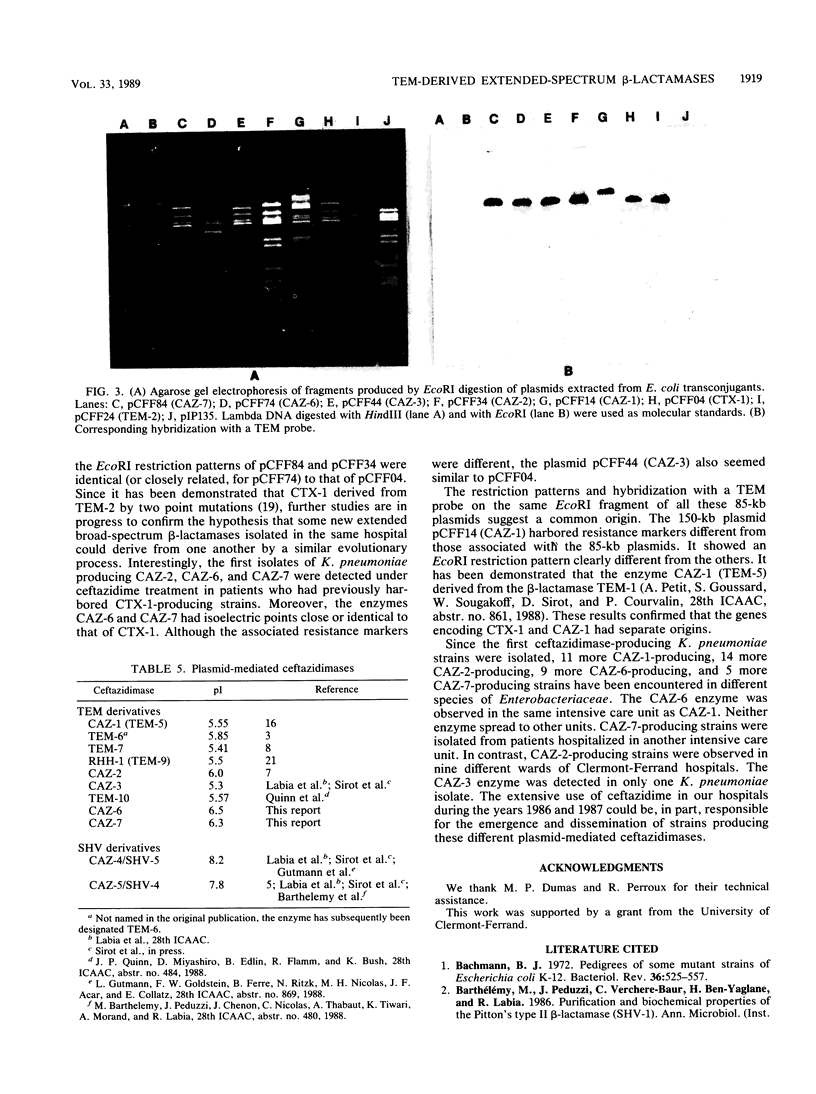
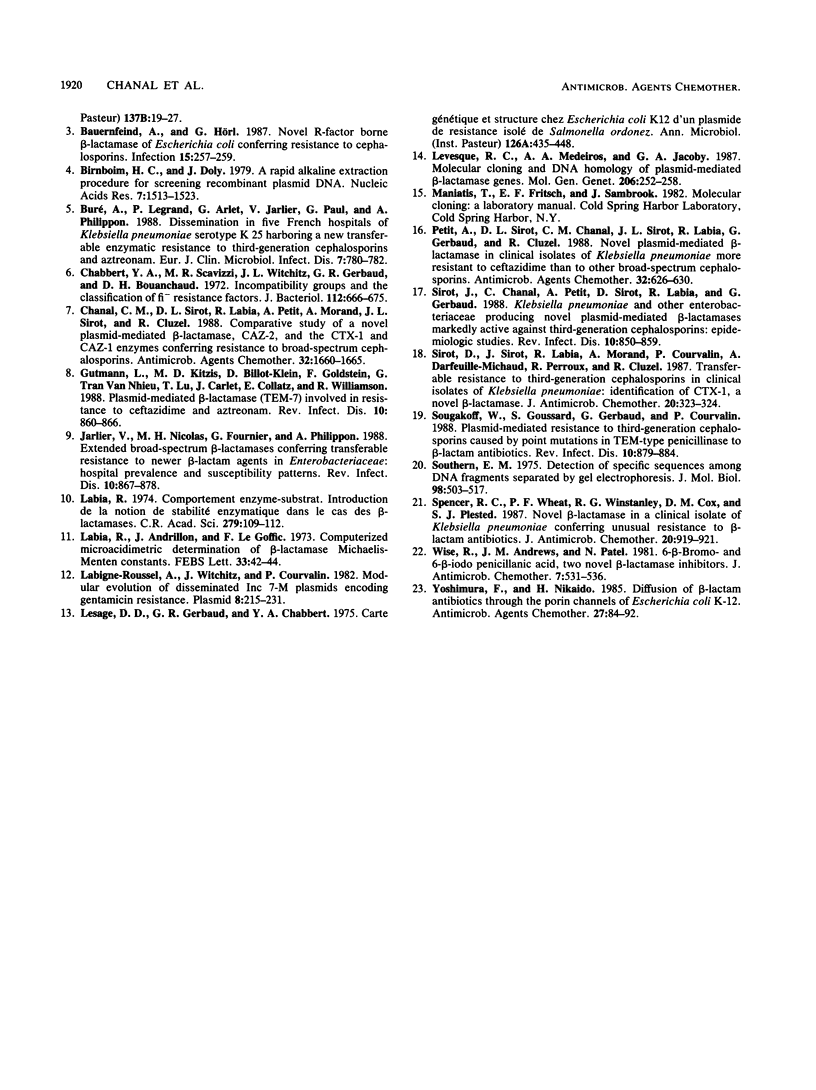
Images in this article
Selected References
These references are in PubMed. This may not be the complete list of references from this article.
- Bachmann B. J. Pedigrees of some mutant strains of Escherichia coli K-12. Bacteriol Rev. 1972 Dec;36(4):525–557. doi: 10.1128/br.36.4.525-557.1972. [DOI] [PMC free article] [PubMed] [Google Scholar]
- Bauernfeind A., Hörl G. Novel R-factor borne beta-lactamase of Escherichia coli confering resistance to cephalosporins. Infection. 1987 Jul-Aug;15(4):257–259. doi: 10.1007/BF01644127. [DOI] [PubMed] [Google Scholar]
- Birnboim H. C., Doly J. A rapid alkaline extraction procedure for screening recombinant plasmid DNA. Nucleic Acids Res. 1979 Nov 24;7(6):1513–1523. doi: 10.1093/nar/7.6.1513. [DOI] [PMC free article] [PubMed] [Google Scholar]
- Buré A., Legrand P., Arlet G., Jarlier V., Paul G., Philippon A. Dissemination in five French hospitals of Klebsiella pneumoniae serotype K25 harbouring a new transferable enzymatic resistance to third generation cephalosporins and aztreonam. Eur J Clin Microbiol Infect Dis. 1988 Dec;7(6):780–782. doi: 10.1007/BF01975048. [DOI] [PubMed] [Google Scholar]
- Chabbert Y. A., Scavizzi M. R., Witchitz J. L., Gerbaud G. R., Bouanchaud D. H. Incompatibility groups and the classification of fi - resistance factors. J Bacteriol. 1972 Nov;112(2):666–675. doi: 10.1128/jb.112.2.666-675.1972. [DOI] [PMC free article] [PubMed] [Google Scholar]
- Chanal C. M., Sirot D. L., Labia R., Petit A., Morand A., Sirot J. L., Cluzel R. A. Comparative study of a novel plasmid-mediated beta-lactamase, CAZ-2, and the CTX-1 and CAZ-1 enzymes conferring resistance to broad-spectrum cephalosporins. Antimicrob Agents Chemother. 1988 Nov;32(11):1660–1665. doi: 10.1128/aac.32.11.1660. [DOI] [PMC free article] [PubMed] [Google Scholar]
- Gutmann L., Kitzis M. D., Billot-Klein D., Goldstein F., Tran Van Nhieu G., Lu T., Carlet J., Collatz E., Williamson R. Plasmid-mediated beta-lactamase (TEM-7) involved in resistance to ceftazidime and aztreonam. Rev Infect Dis. 1988 Jul-Aug;10(4):860–866. doi: 10.1093/clinids/10.4.860. [DOI] [PubMed] [Google Scholar]
- Jarlier V., Nicolas M. H., Fournier G., Philippon A. Extended broad-spectrum beta-lactamases conferring transferable resistance to newer beta-lactam agents in Enterobacteriaceae: hospital prevalence and susceptibility patterns. Rev Infect Dis. 1988 Jul-Aug;10(4):867–878. doi: 10.1093/clinids/10.4.867. [DOI] [PubMed] [Google Scholar]
- Labia R., Andrillon J., Le Goffic F. Computerized microacidimetric determination of beta lactamase Michaelis-Menten constants. FEBS Lett. 1973 Jun 15;33(1):42–44. doi: 10.1016/0014-5793(73)80154-1. [DOI] [PubMed] [Google Scholar]
- Labia R. Comportement enzyme-substrat. Introduction de la notion de stabilité enzymatique dans le cas des beta lactamases. C R Acad Sci Hebd Seances Acad Sci D. 1974 Jul 1;279(1):109–112. [PubMed] [Google Scholar]
- Labigne-Roussel A., Witchitz J., Courvalin P. Modular evolution of disseminated Inc 7-M plasmids encoding gentamicin resistance. Plasmid. 1982 Nov;8(3):215–231. doi: 10.1016/0147-619x(82)90060-9. [DOI] [PubMed] [Google Scholar]
- Lesage D. D., Gerbaud G. R., Chabbert Y. A. Carte génétique et strucutre chez Escherichia coli K12 d'un plasmide de résistance isolé de Salmonella ordonez. Ann Microbiol (Paris) 1975 May-Jun;126A(4):435–448. [PubMed] [Google Scholar]
- Levesque R. C., Medeiros A. A., Jacoby G. A. Molecular cloning and DNA homology of plasmid-mediated beta-lactamase genes. Mol Gen Genet. 1987 Feb;206(2):252–258. doi: 10.1007/BF00333581. [DOI] [PubMed] [Google Scholar]
- Petit A., Sirot D. L., Chanal C. M., Sirot J. L., Labia R., Gerbaud G., Cluzel R. A. Novel plasmid-mediated beta-lactamase in clinical isolates of Klebsiella pneumoniae more resistant to ceftazidime than to other broad-spectrum cephalosporins. Antimicrob Agents Chemother. 1988 May;32(5):626–630. doi: 10.1128/aac.32.5.626. [DOI] [PMC free article] [PubMed] [Google Scholar]
- Sirot D., Sirot J., Labia R., Morand A., Courvalin P., Darfeuille-Michaud A., Perroux R., Cluzel R. Transferable resistance to third-generation cephalosporins in clinical isolates of Klebsiella pneumoniae: identification of CTX-1, a novel beta-lactamase. J Antimicrob Chemother. 1987 Sep;20(3):323–334. doi: 10.1093/jac/20.3.323. [DOI] [PubMed] [Google Scholar]
- Sirot J., Chanal C., Petit A., Sirot D., Labia R., Gerbaud G. Klebsiella pneumoniae and other Enterobacteriaceae producing novel plasmid-mediated beta-lactamases markedly active against third-generation cephalosporins: epidemiologic studies. Rev Infect Dis. 1988 Jul-Aug;10(4):850–859. doi: 10.1093/clinids/10.4.850. [DOI] [PubMed] [Google Scholar]
- Sougakoff W., Goussard S., Gerbaud G., Courvalin P. Plasmid-mediated resistance to third-generation cephalosporins caused by point mutations in TEM-type penicillinase genes. Rev Infect Dis. 1988 Jul-Aug;10(4):879–884. doi: 10.1093/clinids/10.4.879. [DOI] [PubMed] [Google Scholar]
- Southern E. M. Detection of specific sequences among DNA fragments separated by gel electrophoresis. J Mol Biol. 1975 Nov 5;98(3):503–517. doi: 10.1016/s0022-2836(75)80083-0. [DOI] [PubMed] [Google Scholar]
- Spencer R. C., Wheat P. F., Winstanley T. G., Cox D. M., Plested S. J. Novel beta-lactamase in a clinical isolate of Klebsiella pneumoniae conferring unusual resistance to beta-lactam antibiotics. J Antimicrob Chemother. 1987 Dec;20(6):919–921. doi: 10.1093/jac/20.6.919. [DOI] [PubMed] [Google Scholar]
- Wise R., Andrews J. M., Patel N. 6-beta-bromo- and 6-beta-iodo penicillanic acid, two novel beta-lactamase inhibitors. J Antimicrob Chemother. 1981 May;7(5):531–536. doi: 10.1093/jac/7.5.531. [DOI] [PubMed] [Google Scholar]
- Yoshimura F., Nikaido H. Diffusion of beta-lactam antibiotics through the porin channels of Escherichia coli K-12. Antimicrob Agents Chemother. 1985 Jan;27(1):84–92. doi: 10.1128/aac.27.1.84. [DOI] [PMC free article] [PubMed] [Google Scholar]



